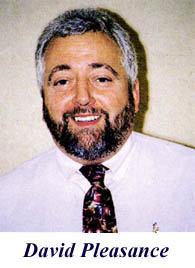
Page: History I / History II
The price for hope
And the winner is: Escom

In spite of all rumours it looked good at the CeBit '94. Much hardware was presented like the A4000T, the CD1200 (an external CD-Rom for the A1200), the long-awaited MPEG-Module for the CD32 or the accelerator-card Afterburner A4050 for the A3000 and A4000. Some things just were available in "a couple of weeks" (well-known from Commodore) or there was not enough publicity. Because some news were presented at all everybody was happy. But a dark cloud laid over Commodore at the exposition: the new founded Commodore Trend Division showed different phones, typewriters and a shredder with the C-logo. Was it just a joke of Commodore Business Machines or should it be a way to cross the financial valley?
It was no secret that Commodore had a lack of money. But nobody could suspect that this giant who marked the computerworld and -history and became the homecomputer market leader was so shaken that the Holding on the Bahamas ordered the voluntary liquidation on April, 29. of 1994. (A voluntary liquidation is no bankruptcy. The law of the Bahamas says that a voluntary liquidation can be undone until the point of the final liquidation.) In the fourth quarter of 1993 Commodore had a loss of 8.2 million dollars. In the same period of the last year the loss was 77.2 million dollars. And in the whole financial year '92/'93 ('til june 30.) the loss reached 356 million dollars with sales of 591 dollars. They saw too late that only the Amiga was successful.
A buyer was already in sight - an asian electronic giant who belongs to the biggest in this part of business. That combine wanted to buy not only the technology and the tradmark Amiga but also the main sales societies. The Amiga should further be build and developed in his well-known form. The plans of this company were to enter the computer-comsumermarket and to use the old ways of distribution of Commodore. Had this deal become successful the Amiga could see marketing activities like never before. The yearly sales of Commodore was the petty cash of the Asian. Not only insiders expected a big advertising to push the next Amigageneration. Negotiations existed. Finally it was the personal touch of the managers. But they messed both up.
The Amiga-technology was not too old. The long delays of the negotiations showed the reason: there were too much interested parties. Always new names fell in the rumours: Sony, Hewlett Packard, Samsung; even Sega and Nintendo were called. On one hand it was good that so much potential buyers wanted to get the Amiga-technology but on the other hand it was very bad because of the long delays much of them canceled their negotiations in the meanwhile (for example Amstrad or Philips). And the takeover from Samsung failed. Another sign for the failures was the info that the employees were looking for new jobs and the Computer '94 opened its doors the first time without Commodore.
One prospective buyer raised hopes: Commodore UK under the leading of David Pleasance. Because he came of own rows and consequently had got the right knowledge. He had many plans for new ways of distribution, productions and new developments. And it looked that Commodore UK got all trumps because the technology was already waiting in the drawers and had just to be fixed. So finally six months later the new Amigas could have been sold. The "old" models should be available in november, so David. He did very self-confident that he already got the sale and the signature was just a formality to do there was no time for 'til now.
At the end of 1994 approximately 7 month after the voluntary liquidation just the two Commodore-devoted companies (Creative Equipment International - CEI and Commodore UK) had a dispute for the patents, rights and licenses of the Amiga. Each of them said that the object will go to them because each had the highest bid. Until December 9, '94 each of them expected the confirmation of the court.

In this time the first datas about the successor of the Amiga the DraCo which should be presented in the early '95 by the german company MacroSystem Computer GmbH reached the public.
In the meantime came another problem because the longer the negotiations the less the value of Commodore. Also the trustee in bankruptcy knew that Commodore would be worthless soon. The liquidation-process was very complicated because the trademark-rights of Commodore were distributed worldwide. For example Commodore Germany had the rights for the C-logo. David said someone stood behind them who had enough money to safe the development and distribution worldwide. Commodore could raise their bid until every other had to give up. Even Dave Haynie wanted to develop new Amigas again after the successful takeover. It was said that they had a new computer called "Hombre" which had a RISC-CPU and should be 25x faster than an A4000/40. And also the AAA-Chips should be used eventually. The project should be finished to a third and 18 months later the world could see a new Amiga.
Almost a whole year later Commodore should be finally sold on April 1995.
| TOP |
